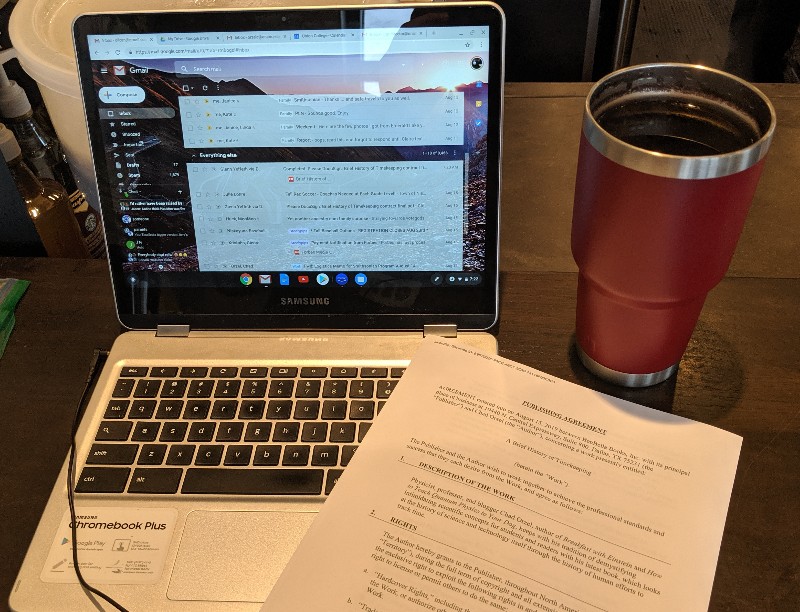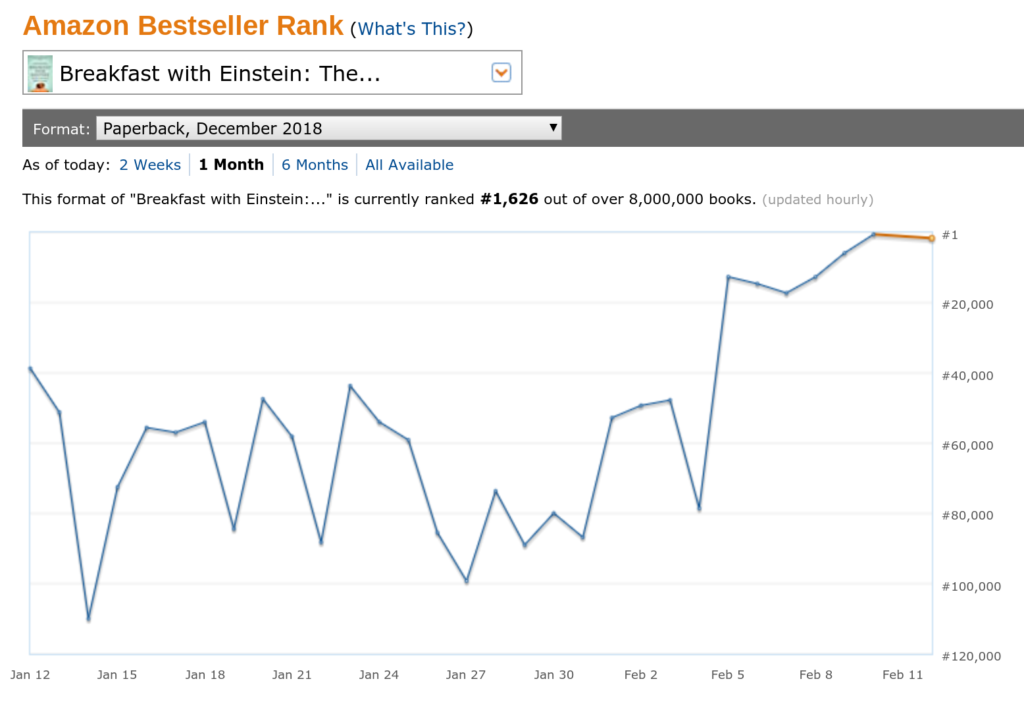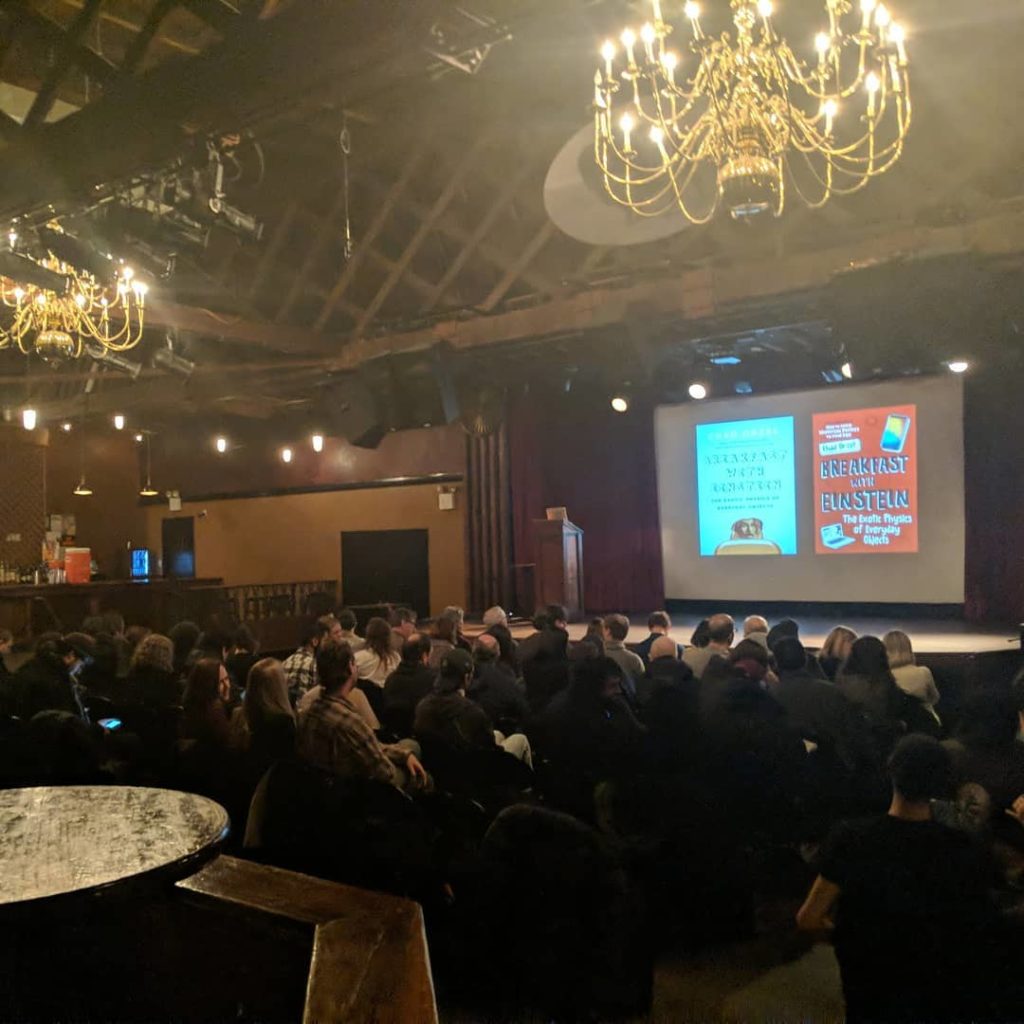As noted a couple of days ago, I turned in the completed manuscript of A Brief History of Timekeeping this week, most of which was written under pandemic conditions. This was, to put it mildly, a bit of a slog, in ways that might be worth writing about a little bit.
Looking at the creation dates of the files in my book-in-progress folder, I had basically four chapters in early draft form before everything went pear-shaped back in March. Up to that point, we had a pretty solid routine established that worked well for me: I would get up at five-ish, eat breakfast and walk the dog, then wake The Pip up around 6:30 to get him started getting ready for school. Kate would get up at around that same time, and take charge of feeding the Little Dude and getting him outside to wait for the bus (which came around 7:30). At about 7am, I would decamp for the Starbucks in Niskayuna, stake out a spot at one end of the bar seating, and stay there working on the book until 9-ish.
This worked really well for a couple of reasons, the primary one being that since I work with earbuds in listening to music, Starbucks is actually a low-distraction environment for me. If I want snacks or another drink, I need to pay for it, which is a significant deterrent, and if anybody else wants something, it’s Not My Problem.
Everything closing down in March blew that right to hell, in a bunch of ways. The entirely predictable one is that having Kate and the kids home during the day adds a huge number of distractions– when the kids want something, it is my problem, and that makes it really hard to get into any kind of flow. This can be mitigated to some degree by using earbuds at my home desktop, but that brings in problems of its own, in that not being able to hear and respond to an initial request will sometimes escalate it to the status of Major Problem.
The less predictable problem is that The Pip turns out to be a Morning Person. In retrospect this is something we maybe should’ve expected, as he really only needed active waking on school days– on weekends, I could open his door and say quietly “If you want to watch cartoons, you can come downstairs now,” and he’d explode out of bed and beat me down the stairs. Once school shut down, every morning was a tv-watching morning, so he started getting up early without prompting. Nine months into this mess, if I wake up before 5, I stay in bed reading until I can’t stand it any more, because the second I get up and start moving around, The Pip is awake and raring to go.
(We had a period where we tried to enforce a 6am limit before he could come downstairs, in hopes that he would go back to sleep, but we gave that up when he was doing things like sitting at the top of the stairs waiting to hear the clock chime. Attempting to get him back to sleep just wasn’t working, and I’m up anyway, so he just comes downstairs whenever I do.)
This is, obviously, a bit of a problem from a get-work-done perspective, but we reached a sort of détente, where he gets to watch videos on his tablet with headphones on, and I provide the basics of breakfast then do my work. He’s independent enough now to go get some of the snack food he eats for himself, without needing my help for anything that isn’t on a really high shelf.
Starting in early July, the kids went to a pandemic version of the day camp at the JCC that they’ve been going to forever, which got them out of the house. Kate’s office re-opened in a complicated manner (she goes in person Monday-Thursday every other week and works from home the other weeks and every Friday), and in September the schools reopened also in a complicated way (The Pip goes in person every day; SteelyKid is in person every other day, and doing remote school the other days). We’ve settled into a reasonably successful new routine as a result.
These days, I come downstairs around 5:30, get The Pip and Charlie the pupper fed, and take Charlie for a walk. That usually gets me home around 7am, and The Pip and I will wait outside for his bus, which comes around 7:20. After that, I run over to Starbucks to pick up my usual order (not because it’s stunningly high-quality tea, or because I think Starbucks the corporation needs my help to survive, but because I like the people who run that particular store, and want to support them), then settle in with earbuds to write. Kate takes care of getting SteelyKid up and downstairs for breakfast (this can be a MAJOR PROJECT; SteelyKid is very much not a Morning Person). If Kate’s working from home, she deals with getting SteelyKid out the door (middle school starts at 9:45) or logged into remote school; if it’s an office week for Kate, I take over once SteelyKid is downstairs.
That gets me a couple of hours of Writing Time at around the same time of day as the prior schedule, but it’s not quite as productive as my Starbucks time used to be. On days when I’m responsible for SteelyKid, that breaks things up a lot, but even when I’m the only human at home, Charlie the pupper is here. Like a lot of dogs, Charlie thinks work-from-home is the Greatest! Thing! EVER!, because he has at least one human around at all times. Which means a lot of chances to come over and alert me to the insolent squirrels in the back yard who urgently need to be chased, like, right now.
And then, of course, there’s the question of food. I do almost all of the meal prep in Chateau Steelypips, so if either of the kids is home, I’m the one in charge of making lunch. Which is not all bad– when I can get SteelyKid to come downstairs, we have some fun conversations at lunchtime– but does break things up. More than that, though, all the snacks in the house have already been paid for, so when I get hungry, it’s really hard not to just go into the kitchen and grab something to eat. And Charlie takes that as a sign that it’s time for an Insolent Squirrel sweep of the back yard, which sometimes takes a while, so everything is broken up way more than it used to be when I could go to a space that wasn’t mine.
(I could go to my office on campus, at least starting in September, but that means being around people, and while I’m not super paranoid about the virus, that doesn’t mean I want to spend long periods of time breathing shared air unless I absolutely have to.)
At the other end of the day, there’s a hard stop around 3pm; on in-person days, SteelyKid gets home around 3:15, and The Pip wants to be picked up from the after-school program at the JCC around 3:45. I usually feed the two of them dinner at about 5pm (if it’s an in-office week for Kate, adult dinner gets held until she gets home), which means starting food prep around 4:30, so that hour’s kind of useless. I’m also trying to be good and fit in an hour-ish of exercise a day (mostly biking or shooting hoops at a park when the weather was nicer) because when I don’t I get to feeling fat and sluggish and am even less able to get shit done than I would be if I tried to not carve out that time.
So, as I said, kind of a slog. Plus the general miasma of News all over everything all the time– the pandemic, the election, the pandemic’s effect on the election, the election’s effect on the pandemic, everybody’s blisteringly stupid Takes on the election and the pandemic and how they affect one another, and on and on. It’s been incredibly hard to focus these last nine months of March, 2020. Back at the beginning of the year, I thought the book was going to cruise to completion in the early fall, giving me a couple of months to do final tweaks and make figures and all that fiddly stuff; as it was, the last chapter or two were slightly stressful, and a bunch of the figures in the submitted draft are place-holders I grabbed off one website or another.
But, it’s done, on time and off to my editor. Which, alas, doesn’t mean a real vacation– I have a partial deadline for another thing in a couple of weeks, and I’ll be team-teaching a course on quantum computing starting in January, which will require some significant prep time. But after a bunch of flailing around, I’ve found something that mostly works to get stuff done in spite of, you know,… everything.





